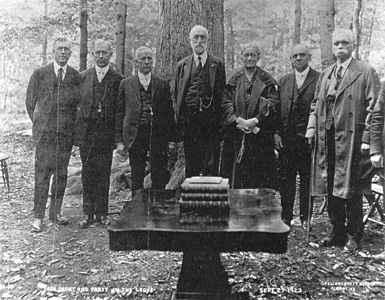
Centennial Observances |

On September 23, 1923, Church leaders met in Palmyra and Manchester, New York, for the centennial of the angel Moroni's first visitation to Joseph Smith on the hill Cumorah. Pictured here in the Sacred Grove (left to right) are Joseph Fielding Smith (second from left), Rudger Clawson, President Heber J. Grant, Sister Augusta W. Grant, James E. Talmage, and Brigham H. Roberts, president of the Eastern States Mission. Photographer: Antoine LeGrande Bunker.
by Steven L. Olsen
The historical consciousness of Latter-day Saints in the twentieth century has been richly expressed in the celebration of centennial anniversaries of important foundational events. Building on the elaborate jubilee (fifty-year) celebrations in 1880 of the organization of the church and in 1897 of the beginnings of the LDS colonization in the American West, the Church ushered in the twentieth century in 1905 with the centenary of the birth of the Prophet Joseph Smith. For this occasion, President Joseph F. Smith led a group of Church leaders and Smith family members to Sharon, Vermont, Joseph Smith's birthplace, and dedicated a memorial cottage and large granite obelisk to his memory. Many LDS congregations held local observances.
The Joseph Smith Memorial became one of the first historical sites of the Church. Following its dedication, the Smith company visited a number of other Mormon historic sites. This tour confirmed a growing interest by Latter-day Saints in preserving their past through the restoration of such historical sites in later commemorations.
Another major centenary was celebrated on September 22, 1927, when President Heber J. Grant conducted a devotional on the hill Cumorah at the approximate location where Joseph Smith received the gold plates of the Book of Mormon from the angel Moroni one hundred years earlier (See Moroni, Visitations of) On September 25, congregations throughout the Church held commemorative programs as part of their Sunday worship services.
The 1930 centenary of the organization of the Church saw a much more ambitious memorial. The major celebration centered on the week of April 6. Church leaders arranged for participation in the festivities to extend beyond the 100,000 who gathered in Salt Lake City by installing radio receivers in more than a thousand meetinghouses within the broadcasting range of ksl radio. For the opening session of General Conference, congregations assembled in these chapels and many others not so equipped. At an appointed time, Latter-day Saints throughout the Church stood and gave the sacred hosanna shout, normally reserved for the dedication of temples. As the General Conference continued on the following Monday and Tuesday, many speakers reviewed the Church's hundred-year legacy. Each evening of the week of April 6-12, the Salt Lake tabernacle was filled to overflowing for the pageant "Message of the Ages," an ambitious stage production by a thousand actors, singers, and musicians that chronicled a sacred history of the gospel. The Church's seven temples were also dramatically illuminated for the centennial. For pioneer day (July 24) that year, Saints from the eastern United States and Canada and missionaries serving in the area gathered to the hill Cumorah to witness "Footprints on the Sands of Time," the first of the pageants at that historic site.
The 1947 centennial of the arrival of the first company of Mormon pioneers into the Salt Lake Valley was the largest LDS celebration to date. The entire year was one of observances throughout the Church, but it centered on July 24. That day included all the traditional Pioneer Day activities—devotionals, concerts, banquets, parades, rodeos, sports contests, and dances—but on a grander scale. Particularly memorable was the reenactment of the Mormon exodus from Nauvoo (see Westward Migration). This modern "pioneer trek" included many Church leaders and other dignitaries who drove the Mormon pioneer trail in automobiles decorated as covered wagons and who rehearsed pioneer activities along the way. At the mouth of Emigration Canyon, east of Salt Lake City, President George Albert Smith dedicated the "this is the place" monument, a series of sculptures created by Mahonri M. Young, grandson of Brigham Young.
The 1980 sesquicentennial of the founding of the Church brought another year-long celebration with a variety of observances by Latter-day Saints worldwide. The highlight of this commemoration came April 6 in conjunction with General Conference. President Spencer W. Kimball dedicated the reconstructed Peter Whitmer, Sr., log home on the original site, in the township of Fayette, New York, where the Church had been organized in 1830. Millions witnessed the occasion via the Church's first satellite broadcast (see Satellite Broadcast System).
Featured in an expanded Pioneer Day parade that year was the display of hundreds of banners made by the young women from throughout the Church expressing their basic values through an artistic tradition dating back to Pioneer Day parades of the nineteenth century.
A number of smaller-scale sesquicentennials have since commemorated both the historical roots of the Church and its early geographical spread beyond the borders of the United States. The most memorable of these were the sesquicentennials anniversaries of the first Latter-day Saint mission to Great Britain (1987)—the first outside North America (see Missions of the Twelve to the British Isles)—and the founding of Nauvoo, Illinois (1989).
(See Daily Living home page; Holidays home page)
Bibliography
Anderson, Paul. "Heroic Nostalgia: Enshrining the Mormon Past." Sunstone 5 (July-Aug. 1980):47-55.
Belding, Patricia. "A Monumental Race with Winter: The Dedication of the Joseph Smith Birthplace." Vermont Life 38 (Fall 1983):45-48.
Bitton, Davis. "The Ritualization of Mormon History." Utah Historical Quarterly 43 (1975):67-85.
Encyclopedia of Mormonism, Vol. 1, Centennial Observances
Copyright © 1992 by Macmillan Publishing Company
All About Mormons |